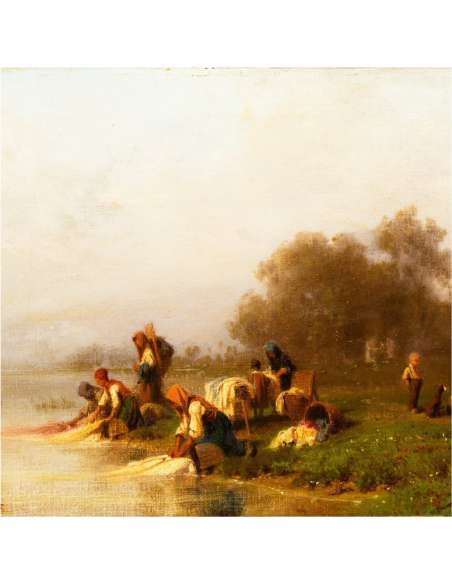Reviews
Oil painting on canvas from the 19th century. Characters by Karl Girardet, The Washerwomen by the River









Period:
Material:
Origin:
- Widht :
- 46,5
- Height :
- 46,5
- Depth :
- 4
- Weight :
- 2
The painting 'Washerwomen' is part of a series of paintings that Girardet created on washerwomen by the river.
As soon as they were presented, they enjoyed considerable success, which continues to this day.
In 2008, another painting from this series was sold at Christie's. Karl Girardet was born in 1813 in Le Locle, which was at the time part of France but which is now in Switzerland. Girardet lived and worked most of his life in Paris.
After beginning his career as a landscape painter, he became a renowned history painter. As a confidant of French King Louis Philippe I, he was also an official court painter. After 1822, he lived in Paris, where he trained as a painter with Louis Hersent and Léon Cogniet.
In 1836, he presented his first works at the Paris Salon and began working as a copyist for the French royal court. An Alpine landscape presented at the Salon of 1837 earned him a first distinction, and he successfully collaborated with Cogniet on two large battle scenes exhibited at Versailles. In 1839, Girardet illustrated his first book, Roland Furious, followed by Boitard's Jardin des Plantes in 1842.
After a six-month stay in Egypt in 1844, he continued to illustrate works and carried out several royal commissions for ceremonial paintings. Enlisted in the National Guard, Girardet witnessed the fall of the monarchy in July 1848 and took refuge in Brienz, Switzerland, where he painted landscapes. In 1850, he returned to France.
In 1857, he set up his studio in the Montmartre district, where he lived until his death, and was admitted to the Royal Academy of Amsterdam. In 1870, caught in a besieged Paris during the invasion of France by the Prussians, Girardet damaged his eyesight while drawing the Prussian positions. Seized with anguish, fearing blindness, he died, alone in his apartment, of suffocation.
He was not married, but had lived for many years with the painter Augustine Angelina Kaas, to whom he had paid a pension. Girardet's art is part of the tradition of romanticism and the popular movement of landscape painting called the "School of 1830". His landscapes, based on sketches often made in adverse weather conditions and in the space of an hour, demonstrate a rare vivacity and mastery of subtle colors, especially after his 1850 stay in Brienz. He was not enchanted by the snow-capped peaks of the Alps, preferring to depict lakes, streams and marshes, notably the rivers Aar, Eure and Marne.[2] Girardet sought official recognition through his historical paintings.
Later in his life, deprived of royal patronage by the political upheavals in France, his historical paintings met with little success, and he reoriented himself towards landscape painting, which he continued to exhibit at the Salon until the end of his life. A man of modest means, Girardet had little leisure time to devote to his art and was forced to earn money mainly as an illustrator.
After 1855, he abandoned the orientalist themes which had contributed to his success; and in his last period, as a diligent craftsman, he devoted himself to the themes and formats in vogue among his bourgeois clients. Girardet's success inspired many other French-speaking Swiss artists and allowed Swiss art and landscapes to be recognized by a wide international audience. Several of his works are exhibited at the Museum of Art and History of Neuchâtel and the National Museum of Versailles.

 English
English  Français
Français








